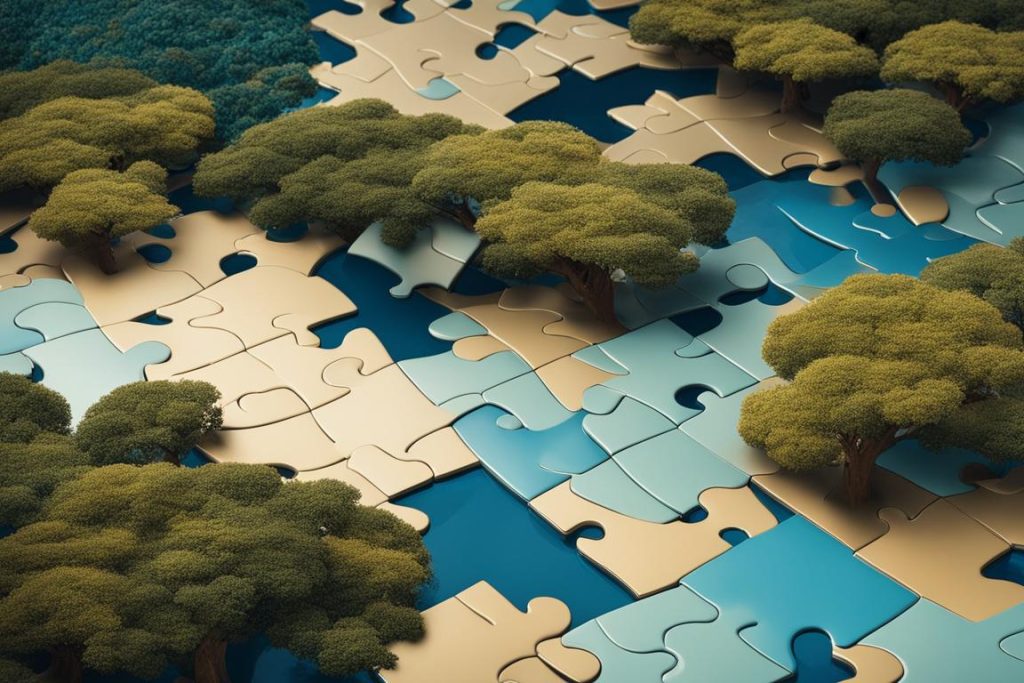Have you ever had a dream where you found yourself in the midst of a massive gathering? Perhaps it was a bustling party, a crowded concert, or a big family reunion. These dreams about large gatherings can hold a deeper meaning than you might imagine. They provide a window into our social subconscious, offering insights into our relationships, desires, and sense of belonging.
In the realm of dreams, large gatherings can symbolize a period of intense happiness and prosperity in our lives. They can also reflect our feelings of inclusion or exclusion and shed light on how we relate to others in real life. Paying attention to specific elements in these dreams, such as costumes or concerts, can provide further clues about our subconscious mind.
Dreaming of Large Gatherings
- Dreams about large gatherings can indicate a period of intense happiness and prosperity.
- They can reflect our feelings of inclusion or exclusion and how we relate to others.
- Specific elements in these dreams, such as costumes or concerts, can provide further insights.
- Exploring the symbolism of crowd-filled dreams can offer a deeper understanding of our social circle and relationships.
- Dreams about parties, concerts, or family gatherings can reveal our desires for conformity or individual ambitions.
The Symbolism of Crowd-Filled Dreams
Dreams have long been a subject of fascination and interpretation, as they offer a glimpse into the workings of our subconscious mind. One common theme in dreams is the presence of large crowds. These crowd-filled dreams carry symbolic meanings that can provide valuable insights into our emotions, desires, and relationships.
When we dream about being part of a crowd, it often represents our need for belonging and acceptance. It may indicate a desire to conform or fit in with societal expectations. On the other hand, feeling excluded or separated from a crowd in a dream can signify a longing to stand out, assert individuality, or pursue personal ambitions.
Furthermore, the specific context of crowd-filled dreams can offer additional layers of interpretation. Dreams about parties, concerts, or family gatherings, for example, reflect our social connections and dynamics. The atmosphere, interactions, and emotions experienced within these dream scenarios can shed light on the quality of our relationships and the level of satisfaction we derive from them.
The Interpretation of Dream Symbols
Within crowd-filled dreams, various symbols may appear that carry significant meanings. Costumes worn by dream characters might represent the facades or roles we adopt in our waking lives. Concerts or performances could symbolize self-expression, creativity, or the desire for recognition. By paying attention to these symbols and analyzing their significance, we can gain deeper insights into our subconscious thoughts and motivations.
| Dream Symbol | Possible Interpretation |
|---|---|
| Costumes | Masking true identity, role-playing, conformity |
| Concerts | Self-expression, creativity, desire for recognition |
| Family Gatherings | Connection, relationships, sense of belonging |
“Dreams are the subconscious mind’s way of communicating with us, offering insights and guidance that may be hidden from our conscious awareness.”
Exploring the symbolism of crowd-filled dreams and deciphering their meanings can be a valuable tool for self-reflection and personal growth. By delving into the subconscious realm, we can gain a deeper understanding of ourselves, our relationships, and our aspirations. Whether we find comfort in the embrace of a crowd or yearn to break free from its confines, our dreams provide a window into our innermost desires and emotions.
Theories on the Purpose of Dreams
When it comes to dreams, there are several theories that attempt to explain their purpose and significance. These theories range from psychological interpretations to neuroscientific explanations, providing different perspectives on why we dream. Understanding these theories can shed light on the mysterious world of dreams and offer insights into the workings of our subconscious mind.
Sigmund Freud’s Psychoanalytic Theory
“Dreams are the royal road to the unconscious.”
Sigmund Freud, the renowned psychoanalyst, proposed that dreams are expressions of our repressed desires and unconscious thoughts. According to Freud’s psychoanalytic theory, dreams serve as a gateway to the unconscious mind, allowing us to access and process hidden desires, fears, and unresolved conflicts. Through dream analysis, Freud believed that we could gain valuable insights into our psyche and uncover the underlying meanings behind our dreams.
Neuroscientific Perspectives
From a neuroscientific perspective, dreams are seen as a result of the brain’s activity during sleep. Research in this field suggests that dreaming serves important functions related to memory consolidation, emotional processing, and cognitive development. During REM sleep, the stage in which most dreams occur, the brain undergoes neural processes that contribute to the content and function of dreams. These processes involve the interplay between different brain regions, shaping the dream experience.
While there is still much to discover about the purpose of dreams, these theories provide valuable insights into the complex workings of our subconscious mind. Whether dreams are seen as expressions of repressed desires or as a way for the brain to process information, they continue to intrigue and fascinate us, offering a window into the hidden depths of our psyche.
The purpose of dreams remains a subject of ongoing research and debate. From Freud’s psychoanalytic perspective to neuroscientific explanations, various theories attempt to unravel the mysteries of dreams. Whether dreams serve as a means for the unconscious mind to express repressed desires or as a mechanism for memory consolidation and cognitive processing, they continue to captivate us with their enigmatic nature.
Exploring the purpose of dreams allows us to delve into the depths of our subconscious mind, gaining insights into our desires, fears, and unresolved conflicts. Whether we view dreams through a psychological lens or a neuroscientific perspective, they offer a glimpse into the inner workings of our psyche, inviting us to unlock the secrets of our dreams and unravel the mysteries of the mind.
The Function of REM Sleep in Dreaming
The process of dreaming is closely linked to the various stages of sleep, with the most vivid and memorable dreams occurring during the rapid eye movement (REM) phase. During REM sleep, the brain exhibits increased activity, similar to that of wakefulness, while the body experiences temporary muscle paralysis to prevent physical movements during dreams.
REM sleep is a crucial component of the sleep cycle, and it plays a fundamental role in the function of dreaming. It is during this stage that the brain processes and consolidates memories, emotional experiences, and cognitive abilities, which are then incorporated into the content of dreams. This process helps to integrate new information with existing knowledge, contributing to learning and memory formation.
Furthermore, REM sleep has been associated with emotional regulation and processing. It provides an opportunity for the brain to process and make sense of the emotions experienced throughout the day, allowing individuals to experience emotional release and gain insights into their emotional well-being. Dreams during REM sleep can often reflect the emotional state of the dreamer and may serve as a way to process and cope with emotional challenges.
Functions of REM Sleep in Dreaming
| Function | Description |
|---|---|
| Cognitive Processing | REM sleep facilitates the consolidation and integration of memories, enhancing learning and problem-solving abilities. |
| Emotional Regulation | REM sleep helps to process and regulate emotions, contributing to emotional well-being and resilience. |
| Creative Thinking | REM sleep has been linked to enhanced creativity and the generation of novel ideas, providing a fertile ground for innovative thinking. |
| Brain Development | REM sleep is essential for the development and maturation of the brain, particularly in infants and young children. |
| Threat Simulation | Dreams during REM sleep may serve as a protective mechanism, allowing individuals to mentally rehearse and prepare for potential threats or challenges. |
REM sleep plays a vital role in the function of dreaming. It provides a stage for the brain to process and consolidate memories, emotions, and cognitive abilities, contributing to the content and meaning of dreams. Understanding the function of REM sleep helps to unravel the mysteries of dreaming and its impact on our cognition, emotions, and overall well-being.
Nightmares and Lucid Dreams
Nightmares and lucid dreams are fascinating aspects of dreaming that offer unique insights into the workings of the subconscious mind. Nightmares, characterized by distressing and fear-inducing experiences during sleep, can often be attributed to underlying stress, trauma, or emotional difficulties. They serve as a reflection of our anxieties and can provide opportunities for personal growth and self-reflection.

On the other hand, lucid dreams are dreams in which the dreamer becomes aware that they are dreaming. This awareness gives them a certain degree of control over the dream content, allowing them to actively participate and shape their dream experiences. Lucid dreaming can be a skill that some people develop, opening up avenues for creativity, exploration, and problem-solving within the dream state.
The Benefits of Lucid Dreaming
Lucid dreaming offers a multitude of benefits beyond the realm of subconscious exploration. It allows individuals to confront their fears, overcome obstacles, and practice new skills in a safe and controlled environment. By actively engaging with the dream scenario, dreamers can gain a sense of empowerment and self-confidence that can extend into their waking lives.
Furthermore, lucid dreaming has been found to aid in creative thinking and problem-solving. Many inventors, artists, and scientists have reported using their lucid dreams to gain inspiration, solve complex problems, and enhance their overall creativity. The ability to harness the power of the dream state can unlock untapped potential and open up new avenues of exploration and innovation.
Nightmares and lucid dreams provide valuable insights into the depths of our subconscious minds. They offer opportunities for personal growth, self-reflection, and even creative problem-solving. By embracing and understanding these aspects of dreaming, we can tap into the vast potential of our inner worlds and unlock new realms of possibility.
Dream Memory and Dream Lag
Dreams have a fascinating connection to our memories and how they are formed. During sleep, our brains consolidate and process information from our daily experiences, and this can often be reflected in our dreams. Dream memory is the ability to recall and remember the content of our dreams, and it plays a crucial role in understanding the messages and symbolism within them.
Dream lag, on the other hand, refers to the delay in incorporating memories into dreams. It is believed that dream lag occurs about a week after an initial experience, as the brain takes time to process and integrate the memories into dream imagery. This lag can result in dreams that combine recent events with older memories, creating unique narratives that provide insights into our subconscious mind.
| Dream Memory | Dream Lag |
|---|---|
| Dream memory is the ability to recall and remember the content of our dreams. | Dream lag refers to the delay in incorporating memories into dreams, often occurring about a week after the initial experience. |
| Dream memory helps us analyze and interpret the symbolism and messages within our dreams, providing valuable insights into our subconscious mind. | Dream lag allows for the integration of recent and older memories, resulting in unique dream narratives that reflect our subconscious processing. |
| Dream memory can be enhanced through practices such as dream journaling and mindfulness techniques. | Dream lag provides an opportunity for the brain to connect and make sense of various memories, contributing to the overall understanding of our dreams. |
Understanding dream memory and dream lag can unravel the complexities of our dreams and help us gain a deeper understanding of ourselves. By paying attention to the content and emotions of our dreams, we can unlock hidden thoughts, desires, and fears that may not be easily accessible in our waking life. Exploring the connection between memory consolidation and dreaming provides valuable insights into the mechanics of our mind and the power of dreams as a tool for self-discovery.
Dream Characters and Their Significance
When we dream, we often encounter a wide range of characters that play different roles and hold various symbolic representations. These dream characters can include people we know in real life, as well as archetypal figures that reflect universal and collective human experiences. Analyzing the appearance, behavior, and emotional attributes of these dream characters can provide valuable insights into our subconscious mind and our waking life relationships.
The dream characters that appear in our dreams are not always direct representations of the individuals they portray. Instead, they often symbolize certain qualities, emotions, or power dynamics that we associate with those people. For example, a dream about a supportive and nurturing friend may indicate a desire for more emotional support in our waking life, while a dream about a menacing authority figure may represent feelings of powerlessness or fear in a particular situation.
Furthermore, dream characters can also represent different aspects of ourselves. They can embody qualities or traits that we admire, envy, or repress. By paying attention to how we interact with these dream characters and the emotions they evoke, we can gain a deeper understanding of our own desires, fears, and unresolved inner conflicts.
Examples of Dream Characters and Their Symbolic Representations
| Dream Character | Symbolic Representation |
|---|---|
| The Wise Old Man/Woman | Wisdom, guidance, and the search for knowledge |
| The Shadow Figure | Repressed emotions, fears, and unresolved conflicts |
| The Romantic Interest | Desire for love, passion, and intimate connections |
| The Parental Figure | Nurturing, guidance, and authority |
| The Hero or Heroine | Strength, courage, and the pursuit of goals |
It is important to note that dream analysis is highly personal, and the meanings of dream characters can vary for each individual. What may hold a specific significance for one person might have a different interpretation for another. Therefore, it is crucial to approach dream analysis with an open mind and trust our own intuition and feelings associated with these dream characters.

By exploring the symbolic representations of dream characters and reflecting on their significance in our own dreams, we can unravel the hidden messages encoded in our subconscious mind. Dream characters serve as gateways to our inner world, offering glimpses into our emotional landscape, desires, and unresolved issues. As we delve deeper into the complex tapestry of our dreams, we embark on a journey of self-discovery and personal growth.
The Neuroscience of Dreaming
Understanding the neuroscience of dreaming allows us to delve deeper into the fascinating world of our subconscious mind. Through advanced brain imaging techniques, researchers have made significant progress in unraveling the mysteries of dream processing and the underlying neural mechanisms involved.
Studies have revealed that dreaming is associated with increased brain activity, particularly during the rapid eye movement (REM) stage of sleep. This heightened neural activity suggests that dreams are not merely random mental events but rather purposeful processes that serve important cognitive and emotional functions.
During dreaming, various brain regions become interconnected and communicate with one another, forming complex networks. For example, the limbic system, which is involved in emotional processing, is highly active during dreams. This activity helps explain the intense emotions often experienced during vivid dreams.
| Brain Region | Function |
|---|---|
| Hippocampus | Memory consolidation |
| Frontal cortex | Cognitive processing and decision-making |
| Amygdala | Emotional processing and fear response |
Furthermore, research has shown that the content of dreams often relates to our real-life experiences and memories. The hippocampus, a key brain region for memory consolidation, plays a vital role in incorporating these memories into dream narratives. This process helps us process and make sense of our daily experiences, contributing to our overall emotional well-being and cognitive development.
The neuroscience of dreaming continues to evolve, offering valuable insights into the complex interplay between our brains and the enigmatic realm of dreams. By further exploring the intricacies of brain activity during dreams, we can gain a deeper understanding of our own minds and the profound impact dreaming has on our psychological experiences.
Dreams as Problem-Solving and Creativity Enhancement
Dreams have long been seen as a platform for problem-solving and creativity enhancement. When we sleep, our brain continues to work on tasks and challenges encountered during our waking hours, leading to insights and solutions that can manifest in our dreams. Research has shown that individuals who dream about a specific task or problem often demonstrate improved performance or creative thinking related to that task after waking up.
During sleep, the brain engages in a process known as cognitive processing. This involves the consolidation and integration of information from our daily experiences, which can then be accessed and utilized in our dreams. As we sleep, the brain makes connections, processes emotions, and combines disparate pieces of information in unique and innovative ways, allowing for the emergence of novel solutions and ideas.
“Dreams are illustrations… from the book your soul is writing about you.” – Marsha Norman
Furthermore, dreams provide a safe space for exploring and experimenting with different possibilities. In our dreams, we are not bound by the limitations of reality, allowing for the manifestation of unconventional ideas and perspectives. This freedom from constraints can stimulate our creativity and inspire us to think outside the box, leading to breakthroughs and innovative solutions.
| Problem-Solving Dreams | Creativity Enhancement |
|---|---|
| Dreams can offer insights and solutions to specific problems or challenges. | Dreams provide a platform for exploring unconventional ideas and perspectives. |
| By processing information and emotions during sleep, dreams can help organize thoughts and facilitate problem-solving. | During dreams, the brain can make novel connections and generate innovative solutions. |
| Individuals who dream about a specific task often demonstrate improved performance or creative thinking related to that task when awake. | Dreams can inspire creative breakthroughs by freeing the mind from the constraints of reality. |

Dream Therapy and Personal Growth
Dream therapy is a powerful tool for personal development and self-reflection. By exploring and analyzing our dreams with a therapist, we can gain valuable insights into our subconscious thoughts, feelings, and desires. This therapeutic approach allows us to delve into the symbols, themes, and emotions present in our dreams, helping us understand ourselves better and resolve inner conflicts.
In dream therapy, the therapist guides us through the interpretation of our dreams, encouraging us to explore the underlying meanings and messages. By examining the relationships between dream characters, the settings, and the emotions experienced during the dream, we can uncover deep-seated patterns and gain a greater understanding of our waking life experiences. Dream therapy provides a safe and supportive space to explore our dreams, leading to personal growth and self-discovery.
One of the key benefits of dream therapy is its ability to foster self-reflection. By reflecting on our dreams and their symbolism, we can gain insights into our unconscious thoughts and desires. Dreams often reveal aspects of ourselves that may be hidden from our conscious awareness, providing valuable guidance for personal growth and transformation. Through dream therapy, we can develop a deeper connection with our inner selves and gain a greater understanding of our true desires and aspirations.
Overall, dream therapy offers a unique opportunity for personal development and self-reflection. By exploring our dreams, we can tap into the rich symbolism of our subconscious and gain insights that can positively impact our waking life. Dream therapy enables us to unlock the hidden messages within our dreams, leading to personal growth, resolution of inner conflicts, and a deeper understanding of ourselves.
Benefits of Dream Therapy
- Provides insights into subconscious thoughts and desires
- Facilitates the exploration of deep-seated patterns and emotions
- Aids in resolving inner conflicts
- Fosters personal growth and self-discovery
- Enhances self-reflection and understanding of oneself
“Dream therapy provides a safe and supportive space to explore our dreams, leading to personal growth and self-discovery.”
Example of Dream Therapy Session
In a dream therapy session, the therapist may ask the client to describe a recent dream in detail. The therapist will listen attentively, taking note of the symbols, themes, and emotions present in the dream. Through gentle questioning and interpretation, the therapist helps the client explore the underlying meanings of the dream.
For example, if a client dreams of being chased by a shadowy figure, the therapist may guide the client to consider what the shadow represents in their waking life. The therapist may ask questions such as, “What emotions did you experience during the dream? How do those emotions relate to your current life circumstances?” By exploring these questions, the client can gain insights into their fears, hidden desires, or unresolved conflicts.
Throughout the session, the therapist provides support and guidance, empowering the client to discover their own interpretations and meanings behind their dreams. The goal of dream therapy is to facilitate self-discovery and personal growth, allowing the client to gain a deeper understanding of themselves and their subconscious.
| Benefits | Example |
|---|---|
| Insights into subconscious | The therapist helps the client uncover hidden desires and emotions through dream analysis. |
| Resolution of inner conflicts | The client gains insights into conflicting thoughts and emotions, leading to resolution and personal growth. |
| Self-reflection and understanding | By exploring dreams, the client gains a deeper understanding of themselves and their true desires. |
| Support and guidance | The therapist provides a safe space for exploration and empowers the client to find their own interpretations. |
Dreaming: A Window into the Unconscious Mind
Dreams offer a fascinating glimpse into the depths of our unconscious mind, providing valuable insights into our innermost thoughts, desires, and fears. Through the analysis of dreams, we can tap into the symbolic language of our subconscious and gain a deeper understanding of ourselves.
Dream analysis is a powerful tool for self-reflection and personal growth. By dissecting the content, symbolism, and emotions present in our dreams, we can uncover hidden aspects of our psyche that may not be easily accessible in our waking life. This process allows us to explore the complexities of our subconscious mind and shed light on unresolved conflicts, unexpressed desires, and latent talents.
“Dreams are the royal road to the unconscious.”
Sigmund Freud
As Sigmund Freud famously wrote, “Dreams are the royal road to the unconscious.” They provide a direct pathway to our deepest thoughts and emotions, bypassing the conscious mind’s filters and defenses. Through dream analysis, we can gain insight into recurring themes, patterns, and symbols that may hold symbolic significance in our waking life. This self-awareness can pave the way for personal growth, allowing us to make conscious choices, heal emotional wounds, and align our actions with our authentic selves.
Exploring the realm of dreams unlocks a rich tapestry of personal narratives, where the subconscious mind weaves together fragments of our experiences, memories, and aspirations. Embracing the wisdom held within our dreams can help us navigate the complexities of our inner world and embark on a transformative journey towards self-discovery and self-actualization.
The Power of Dream Analysis
By delving into our dreams, we can uncover the hidden symbolism that reflects our deepest desires, fears, and unresolved issues. Dream analysis allows us to decode the language of our subconscious, providing valuable insights into our personality, relationships, and inner conflicts. It can serve as a powerful tool for self-reflection, personal growth, and self-awareness.
Unlocking the Secrets of the Unconscious Mind
Our dreams are a window into the mysterious realm of the unconscious mind. Through dream analysis, we can gain a deeper understanding of ourselves, tap into our hidden potential, and embark on a journey of self-discovery. By embracing the messages of our dreams, we can unlock the secrets of our subconscious and navigate the complexities of our inner world with greater clarity and purpose.
Conclusion
After delving into the realm of dreams, it becomes clear that dreaming of large gatherings can provide valuable insights into our social subconscious. These dreams offer a window into our relationships, desires, and sense of belonging. By analyzing the symbols, themes, and emotions present in these dreams, we are able to gain a deeper understanding of ourselves and our interactions with others.
Exploring the psychology and neuroscience of dreaming has allowed us to unlock some of the mysteries of the mind. Dreams serve as a portal to our subconscious, revealing hidden desires, fears, and unresolved issues. Through dream analysis and self-reflection, we can tap into our subconscious and cultivate increased self-awareness and personal growth.
Dreams are powerful tools for introspection and self-discovery. They offer us a unique glimpse into the intricate workings of our minds, shedding light on the complex interplay between our conscious and subconscious selves. So, next time you find yourself dreaming of a large gathering, pay attention to the symbols and emotions within. They just might hold the key to unlocking a deeper understanding of yourself.
FAQ
What do dreams about large gatherings symbolize?
Dreams about large gatherings can indicate a period of intense happiness and prosperity in one’s life. They can also symbolize a sense of inclusion or exclusion and reflect how we relate to others in real life.
What do dreams about crowds represent?
Dreams about large crowds can represent feelings of belonging or exclusion. They may signify conformity or a desire to stand out and pursue individual ambitions.
Why do we dream?
There are various theories on why we dream. Some propose that dreams serve as a way for the brain to process and consolidate information from the day, while others suggest that they simulate real-life experiences or help prepare us for future threats.
What is the function of REM sleep in dreaming?
Dreams most often occur during the rapid eye movement (REM) stage of sleep. REM sleep is characterized by increased brain activity, vivid dreams, and temporary paralysis of the muscles. During this stage, the brain processes and consolidates memories, emotional experiences, and cognitive abilities, contributing to both the content and function of dreams.
What are nightmares and lucid dreams?
Nightmares are distressing dreams that can cause fear and anxiety, often occurring in response to stress, trauma, or emotional difficulties. Lucid dreams are dreams in which the dreamer is aware that they are dreaming and may have some control over the dream content.
How do dreams play a role in memory consolidation?
Dreams can incorporate elements from recent waking life experiences, helping to organize and integrate information from daily experiences. Dream lag refers to the delay in incorporating memories into dreams, often occurring about a week after the initial experience.
What do dream characters represent?
Characters in dreams can represent people known to the dreamer or fulfill certain roles or relationships. The appearance, behavior, and emotional attributes of dream characters can provide insights into the dreamer’s subconscious and their waking life relationships.
What does neuroscience research reveal about dreaming?
Neuroscience research has identified specific brain regions and patterns of activity during dreaming, suggesting that dreams involve the interplay between different regions of the brain. These findings contribute to our understanding of the cognitive and emotional processes underlying dream experiences.
Can dreams help with problem-solving and creativity enhancement?
Dreams can serve as a means for problem-solving and creativity enhancement. The sleeping brain continues to work on tasks and challenges encountered during wakefulness, leading to insights and solutions in dreams.
How can dream therapy aid in personal growth?
Dream therapy, or the exploration and analysis of dreams with a therapist, can be a powerful tool for personal growth and self-reflection. By delving into the symbols, themes, and emotions present in dreams, individuals can gain insights into their subconscious thoughts, feelings, and desires.
What do dreams reveal about the unconscious mind?
Dreams provide a unique glimpse into the workings of the unconscious mind. By analyzing the content and symbolism of dreams, individuals can tap into their subconscious and gain a deeper understanding of themselves. Dream analysis and self-reflection can lead to increased self-awareness and personal growth.




